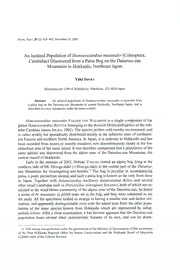
An Isolated Population of Homoeocarabus maeander (Coleoptera, Carabidae) Discovered from a Palsa Bog on the Daisetsu-zan Mountains in Hokkaido, Northeast Japan PDF
Preview An Isolated Population of Homoeocarabus maeander (Coleoptera, Carabidae) Discovered from a Palsa Bog on the Daisetsu-zan Mountains in Hokkaido, Northeast Japan
E、l,t,・a,To(kyo,31(2):439-445,November22,2003 AnIsolatedPopulationofHornoeocarabusmaeander(Coleoptera, Carabidae)DiscoveredfromaPaisaBogontheDaisetsu-zan MountainsinHokkaido,NortheastJapan Yuki IMURA Shinohara-cho1249-8,Kohoku-ku,Yokohama,222-0026Japan Abstract AnisolatedpopulationofHolnoeoca1abtls,naeande1'isrecordedfrom apaisabogontheDaisetsu-zanMountainsincentralHokkaido,NortheastJapan,andis describedasanewsubspeciesunderthenameno/)ll/(11. HomoeocarabusmaeanderFISCHERvoNWALDHEIMisasinglecomponentofthe genusHomoeocarabusREITTERbelongingtothedivisionHemicarabigeniciofthesub- tribeCarabina(sensuIMURA,2002).Thespeciespreferscoldmarshyenvironment,and isratherwidelybutsporadicallydistributedmainlyinthesubarcticzoneofnortheast- ernEurasiaandnorthernNorthAmerica.InJapan,itisendemictoHokkaidoandhas beenrecordedfrommoorsormarshymeadowsnowdiscontinuouslyextantinthelow altitudinalareaofthesameisland.Itwasthereforeunexpectedthatapopulationofthe samespecieswasdiscoveredfromthealpinezoneoftheDaisetsu-zanMountains,the centralmassifofHokkaido. Earlyinthesummerof2003,NobukiYAsuDAvisitedanalpinehogtyingatthe southernsideofMt.Hira-ga-dake(=Hira-ga-take)inthecentralpartoftheDaisetsu- zanMountainsfor investigatingsoilbeetles.1)Thebogispeculiar inaccompanying paisa,apeatypermafrostmoun andsuchapaisabogisknownsofaronlyfromthere inJapan. Together with Au1onocarabus ku1・11ensis dalsetsuzanus KONo and several othersmallCarabidaesuchasPterostlchussubrugosusSTRANEo,bothofwhicharere- strictedtothewind-blowncommunityofthealpinezoneoftheDaisetsu-zan,hefound aseriesofHmaeander inpitfalltrapssetinthebog,andtheyweresubmittedtome forstudy.Allthespecimenslookedsostrangeinhavingasmallersizeanddarkercol- oration,andapparentlydistinguishableevenwiththenakedeyesfromtheotherpopu- lationsof thesamespeciesknown fromHokkaidowhicharerepresentedbysubsp. paludlsGEHIN.Afteracloseexamination,ithasbecomeapparentthattheDaisetsu-zan populationbearsseveral other characteristic featuresof itsown,andcanbedistin- l)ThissurveywasperformedunderthepermissionsoftheMinistryofEnvironment(328thpermission of theWestHokkaidoRegionalOffice forNatureConservation)andtheHokkaido Board of Education (3,046thorderoftheCulturalSection). 440 YukilMURA 9uSihablenotonly「fomSubsp.paludisbutfromalltheknownracesofHmaeander l W加the「etc「edescrbieitasanewsubspeceisinthefololwinglines Theabb「eViatOinSusedinthetextarethesameasthoseexpalinedInmyprevious papers. HOmoeocarabusmaeander,tobukiiIMuRA,subsp nov [Japanesename:Takane-sesujiakagane_osamushj] (Figs.1-3) Len9th:17・7-20・3mm(includingmandibles).Bodyabovedarkreddishcoppery, da「kb「ownO「blackWithacopperylustre,sometmi eswjthafajntgreenishtingeon thelate「alSidesofhead,pronotumandelytra.venterandappendagesbalck MostCloselyalliedtoSubSp.paludis,butreadilydiscrmj jnatedfromthatraceIn thefo11oWin9「eSPeCtS:1)Sizealittlesmalleronanaverage;2)darkjndjv1dua1sarere_l atViely「fequent(ofthetotal23specmi ensexamined,13aredarkreddishcopperyand Fi9S 1 a 1aea1'de'nObufSubSP nov.(1, holotype;2, ,paratype)fromapaisa b g ear I k , No、vIsolatedRaceofHo111oeo_ra/)t1、.111aeande1 441 10aredarkbrownorblackwithacopperylustre),whereastheyaremuchlessfrequent insubsp.paludis);.3)dorsalsurfaceofmandiblesmoresparselyandweaklypunctured; 4)antennaeshorter,barely reachingbasal fifthofelytrainmale,whiletheyusually reachbasalquarterinsubsp.paludis;5)marginalsetaeofpronotumcompletelylostin all thespecimensexamined, whiletwopairsofsetae(onemedianandonebasal)are insertedinsubsp.paludis;6)basal foveaeofpronotumalittleshallower;7)humeral serrationofelytracompletely lost inall thespecimensexamine whereas it is con- stantlyrecognizedinsubsp.paludis. MalegenitalorganasshowninFig 3.Aedeagusslender,weaklybent ventrad near thebase,nearlystraightandparallel-sidedinmedianportionandgraduallybent ventradtowardstheapex; apical lobelongandnarrow,not faintlyconvergentnearthe baseas insubsp.paludisbut almostparallel-sided, itsdorsalmargingently arcuate throughoutandobtuselyroundedatthetipinlateralview;basaledgeofmembraneous preostiumnarrowlyelongate towardsbaseofaedeagusto formalongitudinal furrow ondorsalwalletaedeagus; 0Lmediumtolarge-sized, rather wideat thebaseand bilobedatthetip;1igulumindicatedbyawelldevelopedpatchofpigmentedgranules; neitherBLnorMLdeveloped,thoughdorsalwalletendopha11usapparently inflated near thebase;PREmoderatelyor ratherprominently inflate not bilobedand almost Fig.3. Malegenitalorganofrio,noeoca,-abi1.l111aea,Ido・l11obuki1subspnov. - a,Acdeaguswithfully evertedendopha11usinrightlateralview;b,dittoinposterior(dorsal)view;c,dittoin frontal(ventral) view;d,apicalpartofaedcagusinrightlateralview;e,dittoindorsalview. Arrow indicatesa me m- braneousfurrowonthedorsalwalloftheacdeagus.Scale:lmmfolra-c;0.5mmford&e. 442 Yuki IMURA symmetricalinshape;PPlargeandbilobed,witheachlobealmostsymmetricallypro- trudedandroundedat thetip;PARabsent;ALnotsolargebut ratherstronglypro- truded laterad; PL not inflated; AGGunremarkable,neitherstronglysclerotizednor pigmented. Typeseries. Holotype: ,paisabog,atanaltitudeof1,720m,500-700mdis- tanttothesouthfromthepeakofMt.Hira-ga-dake,inthecentralpartoftheDaisetsu- zanMountainsinCentralHokkaido,NortheastJapan,9-VII-2003,N.YAsUDA leg., preservedinthecollectionoftheDepartmentofZoology,NationalScienceMuseum (Nat.Hist),Tokyo.Paratypes:5 17 ,samecollectingdataasfor theholotype, , inthecollectionsofN.YAsUDAandY. lMURA. Discussion Thehabitatofthepresentnewsubspecies,analpinehogtyingatthesouthernside ofMt. Hira-ga-dake, ispeculiar inaccompanyingpaisa.Paisaisoneof thecircum- glacial landformsdistributedinthepermafrostzone, indicatingapeaty permafrost moundwith the height about 0.5 to temand thediameter exceeding about 2m (WASHBURN,1983).ThepaisabognearHira-ga-dakewasdiscoveredanddescribedfor thefirsttimebyTAKAHAsHlandSONE(1988),andsuchalandformhasnotbeen found sofaranywhereelseinJapan.AccordingtoTAKAHAsH1andSONE(1988),itislocated onabroadpassontheandesiticlavaplateauatanaltitudeof1,720m,measured650m fromeasttowestand350mfromnorthtosouth,attainingtoabout103hainarea.Av- erageannual temperatureatthesamesiteisestimatedatabout -2°C(SONE,2002). The vegetation in thebogismainly composedofsphagnumand sedge.Such plantsas rosef'a oftM ofza, n romeda o/jfofzaand accfmzmoxycoccumarealso as do inant,partlyassociatedwithMenyant fl'lfofzat an rfop ortm vagznattM7.On thesurfaceofthepaisaisdrierthanthesurroundingbog,andiscov- the other han s , ered with fapensfa /appomcav. obovafa, ryantンzf git7e/lmz Get// enfapefa/tm andseveral kindsoflichens,withapartial invasionofyoungPlnuspum11a fromthe surroundingarea(TAKAHAsHI&SONE,1988). Fromthebotanicalpointofview,thispaisabogispeculiar inharboringtwoen- demicspecies;oneisacircumpolarsedge,Care)crotundataWAHLENBERG(SATo & TAKAHAsH1,1994)andtheotherisanarcticmoss,Loeskypnumbadium(HARTM)PAUL (KANDA&SATo,1994).Boththespeciesaredistributedratherwidelyinthecircumbo- rea1tosubarcticzonesoftheNorthernHemisphere,buthavebeen recordedinJapan only fromthebognearHira-ga-dake,andareconsideredtobearelictofthepastcold time. Inviewofthecarabido1ogy,twospeciesofthesubtribeCarabinawereobtained fromthesamebogbypitfall traps.0neisAu1onocarabus(s.str)kurilensisLApoUGE (sensu IMURA,2002,asregardsthegenericclassification) andtheother is Homoeo- car,abus 'naeander FISCHER voN WALDHEIM. The former is represented by subsp daisetsuzanus KONo, whichisoneofthedominantcarabidsin thewind-blowncom- New IsolatedRaceof rio,11oeocalaltls1111eande, 443 munityofthealpinezoneoftheDaisetsu-zanandhashithertobeenrecordedfromthe areabetweenMt.Kuro-dakeandMt.Tomuraushi-yama(YAsUDA,2001).Accordingto YAsUDA(pers.comm), thisspecieswasdominantalsointhebog,thoughpreferring drierenvironment.Incontrast,thelatterwascollected frommarshyplacesaroundthe small pondsoften associated with the palsas, andseemed to beconfined tosuch a strictlynarrowhabitat.TheDaisetsu-zanpopulationofHmaeande1-ispeculiarinsev- eral respectsand doubtlessbelongs toanewsubspeciesasdescribed in thepresent paper InHomoeoca,abusmaeandel-nobuk1i nov.,allthemarginalsetaeofthepronotum arecompletelylostandthehumeralserrationsoftheelytraarenotrecognizable.Inad- dition,thebasaledgeofthemembraneouspreostiumofthemalegenitaliaisnarrowly elongatetowardsthebaseoftheaedeagustoformalongitudinal furrowonitsdorsal wall.Ailthesecharacterstatesarequiteexceptional forthespecies,andareconsidered tobeauniqueautapomorphyoftheDaisetsu-zanrace.Thisseemstorepresenteithera longhistoryafter isolationorarapidmorphological changecausedby itsdistinctive habitat.Inmanyrespects,theymusthavebeenisolatedafterthepastcoldtimewithout minglingwiththeotherpopulationofthesamespecies,andtheoriginandperiodof their immigration intoHokkaidomight havebeen different from those ofsubsp. paludisnowdistributedmuchmorewidelyinthelowaltitudemoorsofthesameis- land. Fig. 4. HabitatofH()1noeoca,・abllsmaeande,・11obukiisubspnov.(paisabog,1,720minalt.,southofMt. Hira-ga-dakeontheDaisetsu-zanMountains;arrowindicatesapaisa;Mt.Hakuun-dakecanbeseenin thedistance)(photographbyN.YAsuD^inJuly2003). 444 Y1lilki IMURA Sincethehabitatofthenewraceislocatedinthespecialprotectionzoneofana- tionalnatureconservationarea,itwillbewellprotectedagainstdisturbancecausedby collectors. Asmentionedintheprecedinglines,however, thehabitat isnarrowlyre- strictedtoasmallalpinebogwhichiscompletelyisolatedfromalltheotherknownlo- calitiesofthesamespecies.Tomakemattersworse, totalareaofthepalsashasbeen gradually reducing for thepastseveraldecades.Forexample, theywerereducedto abouttwo-thirds(rateofreductionwasestimatedat36%)accordingtotheobservation madeby air photographs taken from 1955 to t982 (TAKAHAsHI & SONE, 1988). ThoughH maeande1isnotnecessarilydependinguponthepaisaitself,itseemscer- tainthattheclimaticchangesresultingfromthewarmingoftheglobemayhaveanad- verseeffectonthebogan initsturn,influencethemeager faunaandfloradepending onthisdistinctiveenvironment.Fromsuchapointofview,thenewracemaybeworth regardingasathreatenedlocalpopulation. Acknowledgements IwishtoexpressmydeepindebtednessfirstofalltoMr.NobukiYAsuDA,chief oftheDaisetsuzanNationalParkSounkyoVisitorCenter,withoutwhoseenthusiastic searches,thisremarkablenewpopulationcouldnothavebeenbroughttolight.Hearty thanksshouldalsobeexpressedtoProfessorNobuyukiTAKAHAsHIofHokkai-Gakuen University,Sapporo,andDr.ToshioSONEoftheInstituteofLowTemperatureScience, HokkaidoUniversity, for kindly providingmenecessary literatureof geology and botany, aboveall thoseconcerning thepaisaofDaisetsu-zan, and toMessrs. Mi- tsumasaKAwATAofSapporoandKiyoyukiMlzusAwAofYokosukafortheirkindness inallowingmetoexaminethespecimensofH maeanderpreservedintheircollec- tions forcomparativestudy.Cordial thanksareduetoDr.Shun-IchiUENooftheNa- tionalScienceMuseum,Tokyo, forcriticallyreadingthemanuscriptofthispaper. 要 約 并村有希:北海道大雪山のパルサ湿原から発見されたセスジアカガネオサムシの孤立集 団. _ セスジアカガネオサムシは, 北東ユーラシアから北米にかけての亜寒帯地域を中心 に分布する好湿性の極で, わが国においては北lリf道のみから知られており, これまでに確認さ れた生息地はいずれも低湿地帯ないしそれに準じた環境に限られていた. しかしながら今夏, 大雪山層要峡l ビジターセンターの保田信紀氏により, 大雪山系中央部の平ヶ岳南方較部 (標高 l,720m) にある小湿原から, 同極の特異な小集団が発見された. 同湿原は, 永久凍土地帯に分 布する周氷河地形のひとつであるパルサ (泥炭質の永久凍土丘) を伴つているとぃう点におぃ てきゎて特異であり, わが国唯一のパルサ湿原として知られている. 同地のセスジアカガネォ サムシは, 氷期以降の比較的長い年月を, 他集団との造伝的交流を絶たれた状態で過ごしてき たことは疑いなく, その進入経路や年代も, 道内各地の低湿地に分布している集団とは異なる ものかもしれない. 形態学的にみても, 前月向背板剛毛や肩部鋼歯状突起を欠く点, さらに.、茎 NewIsolatedRaceofHo111oeoca1abus1naeant/e' 445 背面に長く亀裂状に伸張する膜状の清.がみられる点など, いくつかの特徴的な形質をそなえて いることがあきらかになったので, 発見者の保田氏にちなみ, この集団にタカネセスジアカガ ネオサムシsubspnobukiiという新亜種名を与えて記載した.本新亜種の生息地は, 大雪山国立 公園の特別保護区内にあるため, 採集圧による個体数の減少が問題となることはないだろう. しかしながら, その生息地はわずか1.3ヘクタールの面積をもつに過ぎない孤立した湿原であ り, また, 同地のパルサの総面積は年ねん減少しているという. 地球温暖化に伴うこうした環 境条件の変化が, 同地の希少な動植物相にも今後, 少なからぬ影響を与えてゆくであろうこと は明白で, こうした点を考慮に入れると, 本新 種は, 絶減の恐れのある地域個体群に匹敵す る扱いがなされてもよいであろう. References FISCHERvoNWALDHEIM,G.,1820-'22. EntomographiaimperiiRussici,1. viii十208pp.Mosquae. (JEHIN,J.B.,1885. CataloguesynonymiqueetsystematiquedesColeopteresdelatribudosCarabides, avecdosplanchesdessineesparCh.HAuRY. xxxviii十104pp.,10pls.Remiremont&Prague. IMURA,Y.,2002. ClassificationofthesubtribeCarabina(Coleoptera,Carabidae)basedonmolecularphy- logeny. Elyt;a,「okyo,30:1-28. KANDA,H., &K.SATo,1994. Anarcticmoss,Loeskypnumbadiu1n(HARTM)PAUL(Amblystegiaceae), newtoJapan. 1 ス la, lgas1/1-1/1・,os1/1,Ila,11:429 33. KONo,H.,1936. DieKafer-FaunavomDaisetsuGebirge. Biogeog,aphica, nokyo,1:75-104.(InJapa- nese,withGermantitle) LApoUGE,G.V:DE,1913. Carabesnouveaueumatconnus. Misc ent.,21(1):1-241. REITTER,E., l896. Bestimmungs-Tabe1ledereuropaischenColeopteron,Carabidae,1,Carabini,glcich- zeitigmiteinersystematischenDarste11ungsammtlicherSubgeneraderGattungCa,abusL. Vet'1/. natulf Ve,.B,unn,34:36-198. SAT0, K., & N. TAKAHASHl, 1994. Ca''e、.' rotundata WAHLENB. (Cyperaceae) from Mts. Daisetsu in Hokkaido,newtoJapan. J.Jpn.Bet.,69:235-238.(InJapanese,withEnglishtitle) SONE,T.,2002. InternalstructureofapaisainthebogtothesouthofMt.Hiragatake,theDaisetsuMoun- tains,Hokkaido,Japan. JGeog,:,111:546-554. TAKAHAsH1, N., & T. SONE, l988. Palsas in the Daisetsuzan Mountains, central Hokkaido,Japan. Geog,.Rev.Japa,1,61(Ser.A)-9:665-684.(InJapanese,withEnglishtitleandsummary) WASHBURN,A.L.,1983. Whatispaisa?/,1POSER,H.(ed),MesoformcndosheutigenPeriglazialraumes (GeomorphologischesSymposium,KehrbeiGottingen,l982). P・,co., (,ottt,1ge,1Akad.Wiss.,34-47. YAsUDA,N.,2001. Groundbeetlescommunitiesof thehighaltitudezoneinMts.Daisetsu,Hokkaido. Bull.Soml kyoVisito・,Cento,・,(21):1-26.
